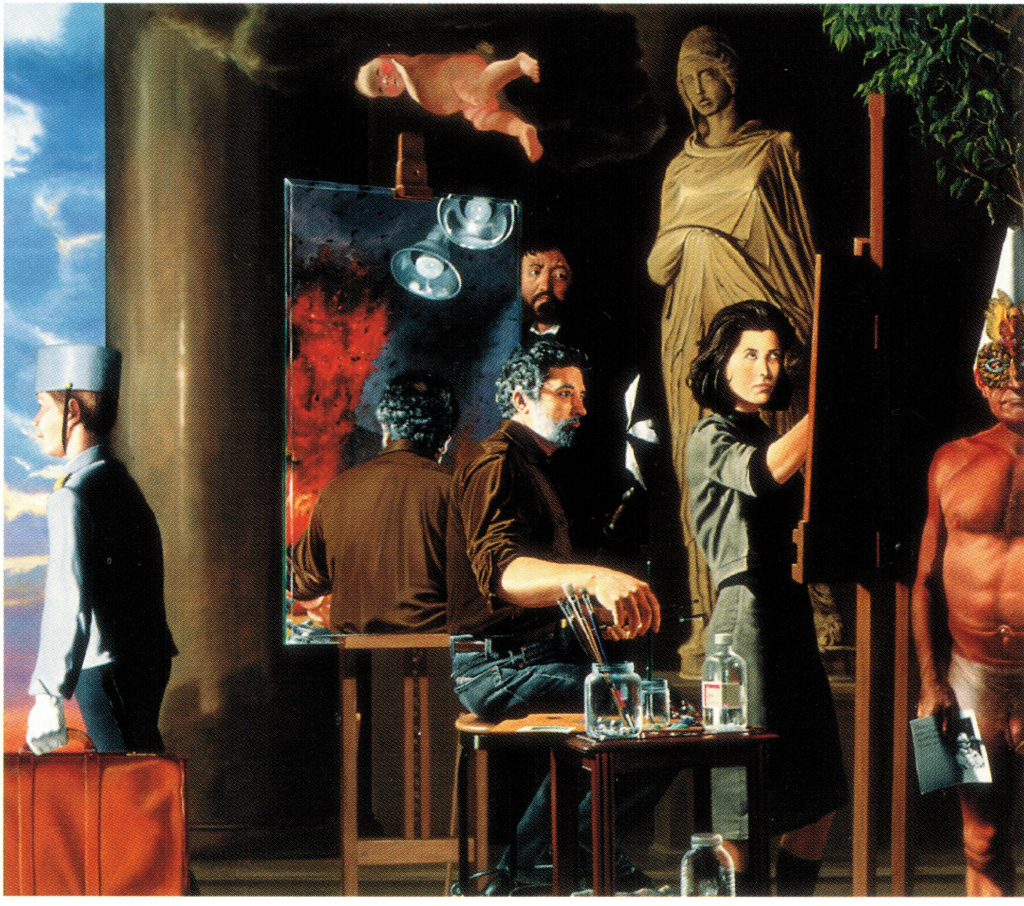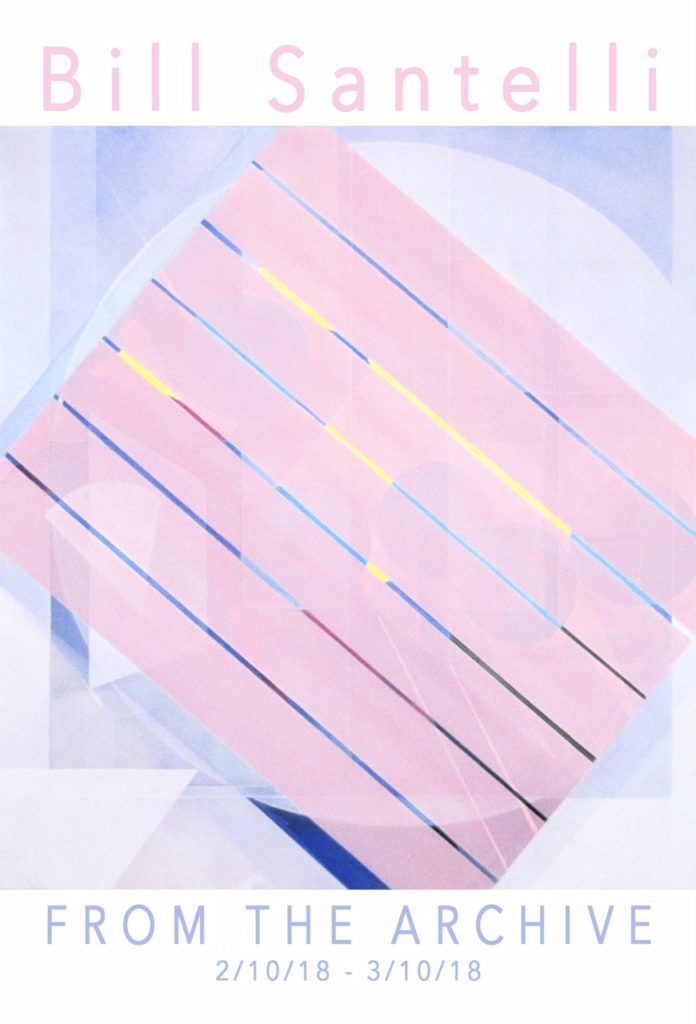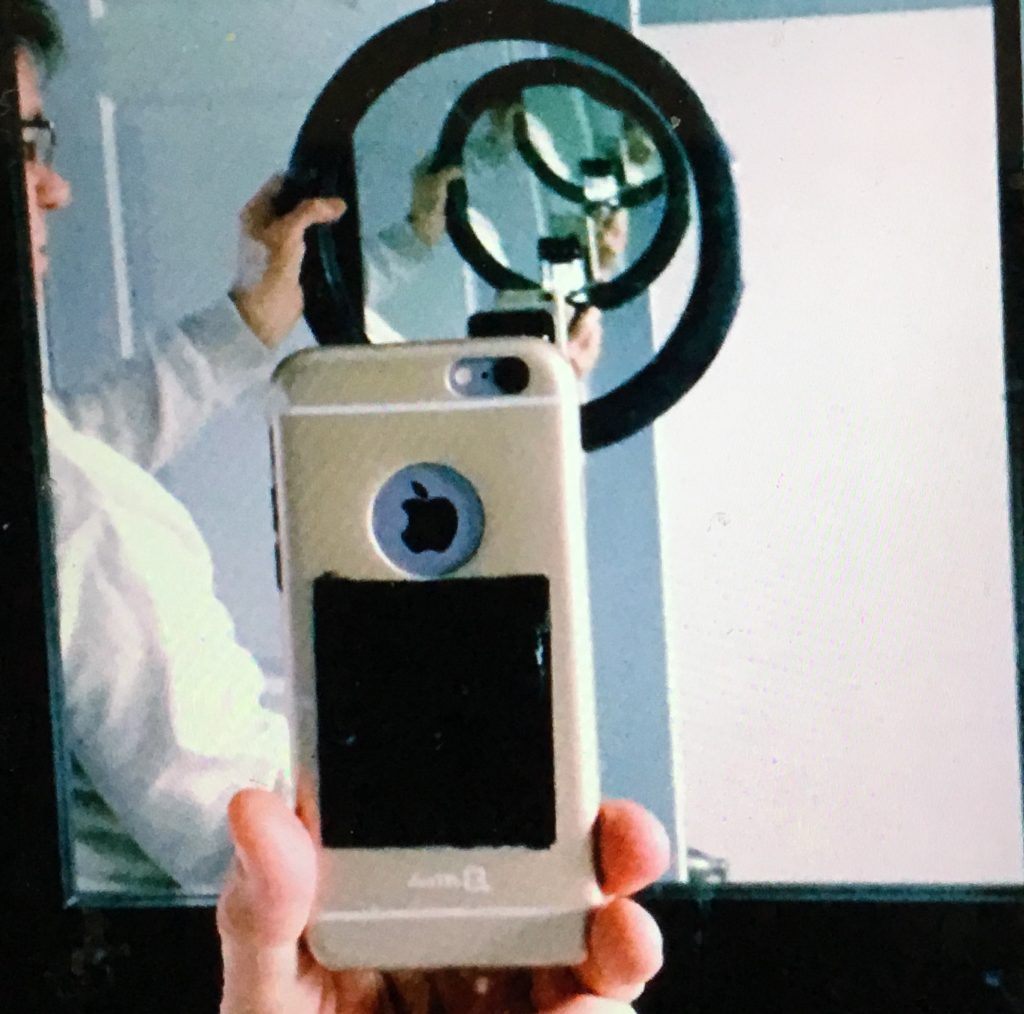February 28th, 2018 by dave dorsey

Tribute #2, Tom Insalaco
Tom Insalaco is a bit of a phantom. After six decades of making art, this award-winning painter continues to create new art every day, but he makes little additional effort to prove that he exists. In a world where social media has become the latest addictive drug and the new hothouse for growing a career, he shuns publicity and refuses to promote himself. A Google search turns up almost nothing about him, except for the samples of his work at Oxford Gallery’s website. He has no website of his own. He has a Gmail address, but insists that he doesn’t know how to use it. At midnight, sometimes, he steals onto the Internet but leaves everything as he found it. He watches art documentaries on YouTube or Netflix, or clicks around to discover another contemporary painter to admire or to see what’s happening at his favorite Manhattan galleries, but he signs off without leaving a public trail. Though he’s as prolific as ever, the Internet has yet to recognize his existence—which means almost no one has access to his five decades of work.[1]
At the age of 75, he rarely enters exhibitions though for decades he has been repeatedly invited into the Memorial Art Gallery’s biennial Rochester/Finger Lakes Exhibition, widely considered the most prestigious show for visual artists throughout New York State west of the Catskills. More often than not, he wins one of the exhibition’s awards. Not long ago, he contacted that museum and asked how many times he had been included in the Finger Lakes show. (He doesn’t keep count of his honors.) He was put on hold for a bit, and the woman returned with a note of surprise in her voice, telling him that he was the single most exhibited artist in the exhibition’s history. His first inclusion was back when he was in graduate school at Rochester Institute of Technology in 1969. Since that phone call, he hasn’t heard from anyone at MAG suggesting maybe it’s time to offer the public a long-overdue Insalaco retrospective. He remains mostly under the radar because he’s too busy making art to worry about whether or not anyone sees it.
His exhibitions have been few and far between, but they have been distinguished. He achieved modest regional fame throughout the state after he completed his monumental Tribute Triptych in the early 90s in reaction to the random murder of his brother. A show was initially organized around it by Finger Lakes Community College, Gallery 1100 in Buffalo and Alfred University. By entering each of these three large paintings serially into different Rochester Finger Lakes exhibitions, he won the top prize three shows in a row. In 1995, the same triptych was the centerpiece of his contribution to a three-artist show along with William Stanley Taft, Jr. and Jerome Witkin. The show featured Witkin’s suite of paintings about Buchenwald alongside Insalaco’s work. In 1996, the triptych made its way into the New York State Biennial at the New York State Museum—participating museums included Albright-Knox, Brooklyn Museum, Memorial Art Gallery, Munson-Williams-Proctor, Queens Museum of Art, and College Art Gallery at SUNY New Paltz. Insalaco’s paintings were shown with work by a small selection of artists from around the state, including Joy Taylor, Stephen Assael, George Wexler, Elizabeth Olbert, and Phil Lonergan. His paintings have also been shown at Everson Museum of Art in Syracuse and the Butler Institute of Art in Ohio, which owns his work. After he retired from a 30-year career of teaching at SUNY/Finger Lakes Community College, the school named its art gallery after him, along with his fellow professor and close friend, sculptor Wayne Williams, who founded the school’s art program along with Insalaco in 1969.
Yet these honors have been rare, partly because Insalaco shuns the art world. He views it with irascible skepticism, casting a gimlet eye on much of what passes for visual art in the 21st century. He paints like an Old Master, without any required postmodern irony to make his antiquated methods feel contemporary. Once upon a time, he worked with great skill as a photo-realist in the wake of that movement’s emergence in the 70s. It was directly after this, in his middle period, as it were, that he constructed vivid visions of his own inner life, painstakingly detailed and realistic, both surreal and Baroque, a visual truce between the 20th and the 17th century. His Tribute Triptych, 104” x 248,” marked this leap forward in his work. At the time, these paintings drew the interest of both curators and critics across the state. Insalaco was poised to become far more widely known. But since then, he withdrew and continued to work mostly out of view. He still paints daily, by artificial light—all windows shuttered or curtained—chasing the glow of Rembrandt, Rubens, and Caravaggio, for the most part, still trying to make mysteries visible, but in a less epic way than in the past.
2
Insalaco isn’t a reactionary. He loves and admires much modern and contemporary art. He regularly books a room in Manhattan and tours both the museums and the galleries, sometimes putting in a week to absorb what he needs to see. In his own idiosyncratic way, he cherry-picks MORE
February 10th, 2018 by dave dorsey

Robert Frost, 1874-1963
From the Robert Hughes documentary on Robert Frost, A Lover’s Quarrel with the World, filmed in the last year of Frost’s life, recently shown on PBS. He talks using the vocabulary of his poetry, the simplest and most elemental language, words as clear as a mountain creek in conversation, and they seem to be just as clear in the poems, though so often they withhold as much as they reveal. His lines are as inexhaustible as Emily Dickinson’s, plain-spoken but sometimes as tough to open up as a koan. The notion of withdrawal here is so resonant as well as the comparison of writing poetry to chopping down a tree or cutting grass–wresting order and form from the world. Hayden Cayruth, in a University of Rochester workshop I attended many years ago, spoke about how the act of writing generates an almost physical pleasure, and that wrestling with words for him actually seemed like a physical task. So much of painting is exactly that: an almost entirely physical, form-making engagement with the world that somehow generates meaning. Does anyone know how that happens? Frost always said he had no idea what a poem would say when he started, but as he worked on it, he followed the words where they led, like ice on a hot stove riding its own melting. The meaning arose from the act of making it, not the other way around.
From the documentary, a few of Frost’s thoughts on poetry, but they might as well be about painting:
Never do it to pay a bill. Because you probably won’t. It comes to market in the long run, but you can’t write it that way. The only self-conscious thought I ever have is “this seems to be going pretty good!” Another step, “still going!” It’s like skating on thin ice when you might go through. Once I’m going, I think it’s like starting a sled at the top of a hill and it goes hard to start but you get right over that gritty place and . . . she goes. We don’t escape. That’s a word I loathe. But retreat. You retreat for strength. You aren’t brought up in the right religion if you don’t know what retreat is. You withdraw . . . I’ve often said that every poem solves something for me in life. I go so far as to say that every poem is a momentary stay against the confusion of the world. But of course any psychiatrist will tell you making a basket or making a horseshoe or giving anything form gives you confidence in the universe, that it has form. When you talk about your troubles, you’re a fool. The best way to settle them is to make something that has form. All that makes you healthy and well is the feeling that there is some sort of poem to your business, your occupation. Two or three of my favorite things are a scythe, a hayfork and a fountain pen.
February 7th, 2018 by dave dorsey

Gateway to a Dream, acrylic on canvas, 46″ x 42″
Bill Santelli is going to be offering his fans a ride in the wayback machine at Maker’s Gallery starting this Saturday. From the Archive will offer a glimpse of Santelli’s work from 1992 through 2000. An opening reception for the exhibit will be from 6 p.m. to 10 p.m. on the 10th. I’ve been liking many samples of his earlier work lately on Instagram. It will be a pleasure to see the real thing.
February 3rd, 2018 by dave dorsey

The comedian and podcast host, Kevin Pollack, says that every good comedian has a bad case of hey-look-at-me-disease. Lesser strains of this malady are common throughout the arts, I think, for better or worse. One thing is certain, social media isn’t the cure.
It’s a truth universally acknowledged that great artists are often self-absorbed. Social media requires us to at least appear to be obsessed with ourselves. But at some point we end up serving this system rather than the other way around—posting everything we do as nourishment for our insatiable “feed.” Being aware of this, I tend to post my latest painting or exhibition with reluctance on Facebook and Instagram, because I think twenty years from now people will look back on this whole phenomenon and think: “How tiresome.” All of this is partly why it took so long for me to write my last post about the recognition I received from Manifest last year–doesn’t this get annoying for some readers?
In a way, the whole social media game is a sweetheart deal for those of us who don’t have mass followings on the Web. It becomes a game of I’ll-like-you-if-you-like-me. (Granted, it isn’t all a mutual schmooze. Most “likes” are sincere.) But social media’s basic OS is reciprocity. You click on other peoples’ like buttons as much as possible to prime the pump for likes in return. Yet isn’t that the definition of an echo chamber? I love coming across an artist now and then for whom I can find no Instagram account. And, ironically, it was refreshing when a now well-known art site that started up a few years ago wrote and asked me to link to their home page, as a way of increasing their rank on Google searches—it was honest and forthright. And I was genuinely impressed with what they were doing. But my attitude is a lot less calculating–I put my work and my thoughts about it out there so that people will discover them if they come looking or else just stumble across it. But hashtags and SEO optimizing search words? It’s never too late to start, I guess. But not today.



